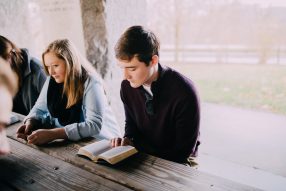
Incorporating “Called to be More” TOB Curriculum in Every Semester
December 12, 2016
In early 2012 I was in the midst of researching how dioceses across the country encourage and implement Theology of the Body within high school classrooms. One particular conversation I had with a superintendent sparked the idea for Called to be More.
The superintendent noted that this particular diocese used to encourage high schools to teach Theology of the Body. With the USCCB’s “Doctrinal Elements of a Curriculum Framework,” however, teachers felt that there was more being required than four years could possibly cover. Therefore, the superintendent concluded, no matter how much willingness was present, there was no time to teach Theology of the Body.
Reflecting on this conversation in the days that followed, I realized that we have a tendency to look at Theology of the Body as something extrinsic to what is being taught in religion class. We place it the box of “Morality” or “Vocations” or use it as a synonym for “Chastity Education.” If we view Theology of the Body in this way, then it seems like something we have to make time for or that we relegate to the days on which the sixth and ninth commandments are discussed.
But what did JP II call Theology of the Body? He referred to it as a “catechesis on human love” and as an “adequate anthropology.” It’s not simply a chastity education program. Rather, the general audiences of St. John Paul II from 1979-1984 are fundamentally about what it means to be human. Since we are human persons, understanding who we are and Who has created and redeemed us is relevant to every aspect of our faith – Scripture, ecclesiology, Christology, social justice, etc.
In light of my conversation with the superintendent, I went through all of the courses in the USCCB’s framework and noted the elements of each course that were related to themes within Theology of the Body. The growing list of bullet points for each semester opened the path to creating a curriculum that engages students in understanding our true identity throughout all four years of high school.
St. John Paul II wrote a letter in the 1960s in which he said that the crisis of the modern age is the “degradation, indeed … a pulverization of the fundamental uniqueness of each human person.” If that was true 50 years ago, imagine how much deeper this crisis has progressed today.
Our young people do not understand who they are. They are unaware of their inherent dignity and the dignity of those surrounding them. There is a common understanding that one has to create himself, inserting meaning onto the blank canvas of life.
But Theology of the Body reminds us that our lives and our bodies are saturated with meaning. The fact that we are created by a God who is Love with the call to love has unending implications for every aspect of our lives. When this exciting news is shared consistently during every semester of high school, our young people can begin to understand their true identity.
Rather than an obstacle to teaching this “catechesis on human love,” the USCCB’s framework is an opportunity to reflect with our students on who God is and how these truths illuminate who we are. Then in contemplating who we are, we can understand why we are called to act in conformity with this dignity.
Called to be More aims to meet society’s “degradation” and “pulverization” of the human person head on by bringing young people on a four year journey to understand more fully who God has created them to be.
Share